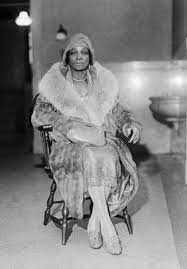TW: rape, racism, mob violence, murder, anti-semitism
This month’s Kickass Woman is a woman of complex morals who, despite making a lavish living through crime, was adored in Harlem during the Harlem Renaissance. Stephanie St. Clair, known as Queenie, ran a numbers racket throughout the 1920s and 30s and kept control of it despite efforts of the Mafia and the Law to take her down. She was also a civil rights activist, who invested in Black-owned businesses and posted ads and op-eds in the paper that protested against police brutality and other forms of racism.
It’s difficult to write about St. Clair because she invented a lot of her history so her story is full of contradictions and unverified legends. St. Clair was almost certainly born in the Caribbean, although she told people that she was born in France, stating that she was “French-European.” She spoke fluent French and Spanish in addition to English. She was probably born in 1897, and she made her way to Canada in 1911 to be a domestic worker. From there she came to New York City.
Her early years were steeped in violence. Stories tell of how she fell in love with a man who became brutal. She stabbed him in the eye with a fork when he tried to force her into sex work.
TW/CW sexual assault
Afraid she’d be arrested for his murder, she is said to have fled the scene on a bus that was subsequently attacked by members of the KKK, who raped her. She survived that attack and is said to have fallen in with another boyfriend. This one tried to choke her, upon which she knocked him into a coffee table and he hit his head and died.
Given this history, it’s not surprising that she once posted an ad in the paper that read:
I have received letters and telephone messages from men which have annoyed me very much and I take this occasion to ask them publicly to please not annoy me. I, Mme. St. Clair, am not looking for a husband or a sweetheart. If they do not stop annoying me, I shall publish their names and letters in the newspaper.
At any rate, somehow St. Clair came up with $10,000 in seed money and started a numbers racket, a kind of illegal lottery. Sometimes called “policy banking,” it worked as a lottery but it also gave Black investors a way to invest their money, which was important because very few banks accepted Black clients. St. Clair was wildly successful, making about $20,000 a year, an unbelievable fortune for the time period. Ruthless to opponents, St. Clair was kind and generous to community members, supporting local, Black-owned businesses and community endeavors with her wealth and using the newspapers as a platform for education and activism. She lived in a Harlem building with other luminaries including W.E.B. Dubois and Madame C.J. Walker. Always conscious of her image, she dressed impeccably and was often seen in a billowing fur coat and a turban.
St. Clair often published op-eds and advertisements in which she complained of police brutality against Black people. When police planted evidence on her and arrested her, she testified in court about kickbacks she paid to police, which led to the firing of over a dozen officers. She was not a person to mess with.
During the Great Depression, the mafia tried to take over her business. None was more persistent than Dutch Schultz. St. Clair battled him with a mixture of violence, intimidation tactics, and public appeals. Rejected Princesses describes the war between them:
St. Clair’s revenge was swift and brutal. When, at one point, Schultz sent an underling to intimidate her, she pushed the underling into a closet, locked him in, and called in four massive bodyguards to “take care of him.” She attacked and destroyed the storefronts of any business that ran Schultz’s betting operations. She tipped the police off to Schultz’s operations – which led to them raiding his clearing house, arresting 14 employees, and seizing around $2 million. She then bragged about it in the press because she gave somewhere in the neighborhood of zero fucks.
Eventually Schultz was shot by other rivals. As he lay dying in the hospital, St. Clair sent a single, simple message, “As ye sow, so shall ye reap.”

Gradually St. Clair retired from the numbers game, leaving her business to her long-time enforcer and bodyguard, Ellsworth “Bumpy” Johnson.” In a marriage contract that was not recognized by law, St. Clair married a man named Sufi Abdul Hamid (born Eugene Brown). He had adopted this name when he converted to Islam and was a labor and civil rights activist, pushing White business owners to hire Black workers. He was also virulently anti-Semitic, to the degree of earning the nickname “The Black Hitler.”
The relationship between St. Clair and Hamid ended when she found out that he was having an affair with a famous psychic named Madame Fu Futtam (Dorothy Matthews). St. Clair shot at him, but he survived and went on to marry Madame Futtam. He died in a plane crash when he was trying to convince people that airplanes could fly on very little fuel, a theory that he proved to be resoundingly incorrect.
Most sources say that St. Clair retired and lived the rest of her life in quiet luxury. Bumpy Johnson lived with her toward the end of both of their lives. She died in her 70s, a respected businesswoman.
Sources:
Queenie: Godmother of Harlem by Elizabeth Colomba and Aurelie Levy

